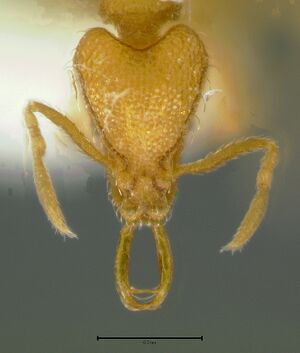Strumigenys juliae
| Strumigenys juliae | |
|---|---|

| |
| Scientific classification | |
| Kingdom: | Animalia |
| Phylum: | Arthropoda |
| Class: | Insecta |
| Order: | Hymenoptera |
| Family: | Formicidae |
| Subfamily: | Myrmicinae |
| Tribe: | Attini |
| Genus: | Strumigenys |
| Species: | S. juliae |
| Binomial name | |
| Strumigenys juliae Forel, 1905 | |
Known from a few litter samples in wet forest and rainforest. Tang & Guenard (2023) report it in primary forest, secondary forest, mature forest and rubber plantation.
Identification
Bolton (2000) – A member of the godeffroyi complex in the Strumigenys godeffroyi-group. See notes under Strumigenys godeffroyi.
Keys including this Species
Distribution
The new records in Thailand and Vietnam extend the species’ geographical range more than 1000 km northward into the Indochinese Peninsula, and indicate that it may also be present in the nearby country of Cambodia (Tang & Guenard, 2023).
Latitudinal Distribution Pattern
Latitudinal Range: 12.2° to -6.587°.
| North Temperate |
North Subtropical |
Tropical | South Subtropical |
South Temperate |
- Source: AntMaps
Distribution based on Regional Taxon Lists
Indo-Australian Region: Borneo, Indonesia (type locality), Malaysia, Philippines, Singapore.
Oriental Region: Thailand, Vietnam.
Distribution based on AntMaps
Distribution based on AntWeb specimens
Check data from AntWeb
Countries Occupied
| Number of countries occupied by this species based on AntWiki Regional Taxon Lists. In general, fewer countries occupied indicates a narrower range, while more countries indicates a more widespread species. |

|
Estimated Abundance
| Relative abundance based on number of AntMaps records per species (this species within the purple bar). Fewer records (to the left) indicates a less abundant/encountered species while more records (to the right) indicates more abundant/encountered species. |

|
Biology
|
Castes
Worker
  
| |
| . | Owned by Museum of Comparative Zoology. |
Nomenclature
The following information is derived from Barry Bolton's Online Catalogue of the Ants of the World.
- juliae. Strumigenys juliae Forel, 1905c: 12 (w.) INDONESIA (Java). See also: Bolton, 2000: 793.
Unless otherwise noted the text for the remainder of this section is reported from the publication that includes the original description.
Description
Worker
Bolton (2000) - TL 2.0-2.2, HL 0.55-0.59, HW 0.38-0.42, CI 67-73, ML 0.24-0.27, MI 43-48, SL 0.32-0.34, SI 79-87, PW 0.24-0.27, AL 0.58-0.62 (16 measured).
Characters of godeffroyi-complex. Cephalic dorsum with pair of erect hairs closest to midline on occipital margin short stiff and erect, straight to shallowly evenly curved but the apical half not abruptly curved anteriorly nor looped. With head in full-face view the dorsolateral margin posterior to the flagellate apicoscrobal hair has a row of 3-4 stiffly projecting hairs. These hairs contrast with the marginal hairs anterior to the flagellate hair as they are more cylindrical (i.e. not spatulate), more elevated and less strongly curved anteriorly. Ground-pilosity on pronotal dorsum sparse and dilute, not appearing as a pelt. Dorsum and side of pronotum smooth and shining (when clean), frequently completely without punctate sculpture. Dorsum of pronotum with a pair of erect flagellate hairs in addition to the humeral pair. Pleurae and side of propodeum mostly to entirely smooth, any reticulate-punctate sculpture present is confined to periphery. Propodeal declivity with a broad and very conspicuous lamella. Propodeal teeth at most only weakly expressed (may be vestigial), entirely confluent with the lamella and surmounted by a narrow convex crest of spongiform tissue. Disc of postpetiole unsculptured. Basigastral costulae conspicuous but not extending half the length of the tergite.
Type Material
Bolton (2000) - Syntype workers, INDONESIA: Java, Depok and Bogor ( = Buitenzorg), iii.1904 (K. Kraepelin) (Musee d'Histoire Naturelle Genève) [examined].
References
- Bolton, B. 2000. The ant tribe Dacetini. Memoirs of the American Entomological Institute. 65:1-1028. (page 793, redescription of worker)
- Emery, C. 1924f [1922]. Hymenoptera. Fam. Formicidae. Subfam. Myrmicinae. [concl.]. Genera Insectorum 174C: 207-397 (page 321, catalogue)
- Forel, A. 1905f. Ameisen aus Java. Gesammelt von Prof. Karl Kraepelin 1904. Mitteilungen aus dem Naturhistorischen Museum in Hamburg 22: 1-26. (page 12, worker described)
- Tang, K. L., Guénard, B. 2023. Further additions to the knowledge of Strumigenys (Formicidae: Myrmicinae) within South East Asia, with the descriptions of 20 new species. European Journal of Taxonomy 907, 1–144 (doi:10.5852/ejt.2023.907.2327).
- Wang, W.Y., Soh, E.J.Y., Yong, G.W.J., Wong, M.K.L., Benoit Guénard, Economo, E.P., Yamane, S. 2022. Remarkable diversity in a little red dot: a comprehensive checklist of known ant species in Singapore (Hymenoptera: Formicidae) with notes on ecology and taxonomy. Asian Myrmecology 15: e015006 (doi:10.20362/am.015006).
References based on Global Ant Biodiversity Informatics
- Bolton, B. 2000. The Ant Tribe Dacetini. Memoirs of the American Entomological Institute 65
- Chapman, J. W., and Capco, S. R. 1951. Check list of the ants (Hymenoptera: Formicidae) of Asia. Monogr. Inst. Sci. Technol. Manila 1: 1-327
- Forel A. 1905. Ameisen aus Java. Gesammelt von Prof. Karl Kraepelin 1904. Mitt. Naturhist. Mus. Hambg. 22: 1-26.
- Pfeiffer M., and D. Mezger. 2012. Biodiversity Assessment in Incomplete Inventories: Leaf Litter Ant Communities in Several Types of Bornean Rain Forest. PLoS ONE 7(7): e40729. doi:10.1371/journal.pone.0040883
- Pfeiffer M.; Mezger, D.; Hosoishi, S.; Bakhtiar, E. Y.; Kohout, R. J. 2011. The Formicidae of Borneo (Insecta: Hymenoptera): a preliminary species list. Asian Myrmecology 4:9-58
- Sukimin S., M. Mohamed, and H. Aris. 2010. Ant diversity of Maliau Basin Conservation Area, Sabah, Malaysia. Journal of Tropical Biology and Conservation 6:89-101.

